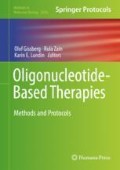Abstract
Cationic peptides designed for cellular delivery of nucleic acid molecules form noncovalent nanocomplexes with negatively charged oligonucleotides (ON). The electrostatically associated complexes are further compacted by hydrophobic interactions yielding nanoparticles (NP) of homogeneous shape and size that are efficiently taken up by cells. The shape and size of NP often correlate with the biological activity of delivered ON inside cells; and the stability and accessibility of NP in biological fluids govern its circulation in organism and the cellular uptake. Therefore, here we provide protocols for characterizing the shape and size and surface charge of peptide/ON NP by negative staining transmission electron microscopy (TEM) and dynamic light scattering (DLS) respectively, and analysis of NP stability against proteolytic degradation.
Access this chapter
Tax calculation will be finalised at checkout
Purchases are for personal use only
References
Godfrey C, Desviat LR, Smedsrod B et al (2017) Delivery is key: lessons learnt from developing splice-switching antisense therapies. EMBO Mol Med 9:545–557
Aartsma-Rus A (2016) New momentum for the field of oligonucleotide therapeutics. Mol Ther 24:193–194
Nikam RR, Gore KR (2018) Journey of siRNA: clinical developments and targeted delivery. Nucleic Acid Ther 28:209–224
Kulkarni JA, Cullis PR, van der Meel R (2018) Lipid nanoparticles enabling gene therapies: from concepts to clinical utility. Nucleic Acid Ther 28:146–157
Stewart MP, Sharei A, Ding X et al (2016) In vitro and ex vivo strategies for intracellular delivery. Nature 538:183–192
Stewart MP, Langer R, Jensen KF (2018) Intracellular delivery by membrane disruption: mechanisms, strategies, and concepts. Chem Rev 118:7409–7531
Beierlein JM, McNamee LM, Ledley FD (2017) As technologies for nucleotide therapeutics mature, products emerge. Mol Ther Nucleic Acids 9:379–386
Pooga M, Langel Ü (2015) Classes of cell-penetrating peptides. Methods Mol Biol 1324:3–28
Lehto T, Ezzat K, Wood MJA et al (2016) Peptides for nucleic acid delivery. Adv Drug Deliv Rev 106:172–182
Margus H, Padari K, Pooga M (2012) Cell-penetrating peptides as versatile vehicles for oligonucleotide delivery. Mol Ther 20:525–533
Arukuusk P, Pärnaste L, Hällbrink M et al (2015) PepFects and NickFects for the intracellular delivery of nucleic acids. Methods Mol Biol 1324:303–315
Veiman KL, Mäger I, Ezzat K et al (2013) PepFect14 peptide vector for efficient gene delivery in cell cultures. Mol Pharm 10:199–210
Ezzat K, Helmfors H, Tudoran O et al (2012) Scavenger receptor-mediated uptake of cell-penetrating peptide nanocomplexes with oligonucleotides. FASEB J 26:1172–1180
Andaloussi SE, Lehto T, Mäger I et al (2011) Design of a peptide-based vector, PepFect6, for efficient delivery of siRNA in cell culture and systemically in vivo. Nucleic Acids Res 39:3972–3987
Urgard E, Lorents A, Klaas M et al (2016) Pre-administration of PepFect6-microRNA-146a nanocomplexes inhibits inflammatory responses in keratinocytes and in a mouse model of irritant contact dermatitis. J Control Release 235:195–204
Margus H, Arukuusk P, Langel Ü et al (2016) Characteristics of cell-penetrating peptide/nucleic acid nanoparticles. Mol Pharm 13:172–179
Herd H, Daum N, Jones AT et al (2013) Nanoparticle geometry and surface orientation influence mode of cellular uptake. ACS Nano 7:1961–1973
Kulkarni JA, Darjuan MM, Mercer JE et al (2018) On the formation and morphology of lipid nanoparticles containing ionizable cationic lipids and siRNA. ACS Nano 12:4787–4795
De Carlo S, Harris JR (2011) Negative staining and cryo-negative staining of macromolecules and viruses for TEM. Micron 42:117–131
Philo JS (2006) Is any measurement method optimal for all aggregate sizes and types? AAPS J 8:E564–E571
Domingues MM, Santiago PS, Castanho MA et al (2008) What can light scattering spectroscopy do for membrane-active peptide studies? J Pept Sci 14:394–400
Borm PJ, Robbins D, Haubold S et al (2006) The potential risks of nanomaterials: a review carried out for ECETOC. Part Fibre Toxicol 3:11
Pärnaste L, Arukuusk P, Langel K et al (2017) The formation of nanoparticles between small interfering RNA and amphipathic cell-penetrating peptides. Mol Ther Nucleic Acids 7:1–10
Freimann K, Arukuusk P, Kurrikoff K et al (2018) Formulation of stable and homogeneous cell-penetrating peptide NF55 nanoparticles for efficient gene delivery in vivo. Mol Ther Nucleic Acids 10:28–35
Anthis NJ, Clore GM (2013) Sequence-specific determination of protein and peptide concentrations by absorbance at 205 nm. Protein Sci 22:851–858
Acknowledgments
This study was supported by the Estonian Ministry of Education and Research grant 0180019s11, PUT1617P (K.P. and M.P.) and IUT20-26 (L.P. and P.A.) from the Estonian Research Council. The funders had no role in study design, data collection and interpretation, or the decision to submit the work for publication.
Author information
Authors and Affiliations
Corresponding author
Editor information
Editors and Affiliations
Rights and permissions
Copyright information
© 2019 Springer Science+Business Media, LLC, part of Springer Nature
About this protocol
Cite this protocol
Padari, K., Porosk, L., Arukuusk, P., Pooga, M. (2019). Characterization of Peptide–Oligonucleotide Complexes Using Electron Microscopy, Dynamic Light Scattering, and Protease Resistance Assay. In: Gissberg, O., Zain, R., Lundin, K. (eds) Oligonucleotide-Based Therapies. Methods in Molecular Biology, vol 2036. Humana, New York, NY. https://doi.org/10.1007/978-1-4939-9670-4_7
Download citation
DOI: https://doi.org/10.1007/978-1-4939-9670-4_7
Published:
Publisher Name: Humana, New York, NY
Print ISBN: 978-1-4939-9669-8
Online ISBN: 978-1-4939-9670-4
eBook Packages: Springer Protocols

